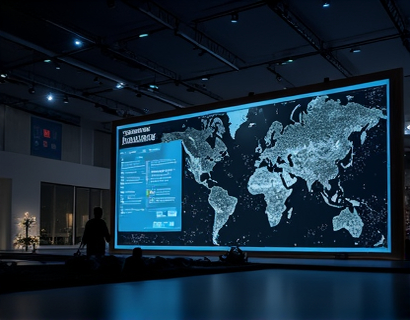Maximizing Global Connectivity: Leveraging Cutting-Edge Distributed Networks for Enhanced Business Communication and Operations
In the rapidly evolving landscape of global business, the ability to maintain seamless and efficient communication across vast distances is crucial. The traditional models of networking are being redefined by the advent of advanced distributed network solutions. These cutting-edge technologies are designed to revolutionize connectivity, ensuring that businesses can expand their global presence and optimize their operations with unprecedented reliability and efficiency. This article delves into the transformative potential of distributed networks, exploring how they can enhance business communication and operations on a global scale.
The core advantage of distributed networks lies in their architecture, which spreads resources and data across multiple nodes rather than relying on a central server. This decentralized approach not only enhances security by reducing single points of failure but also significantly improves performance and scalability. For businesses operating in multiple regions, this means that data can be processed and transferred more quickly, reducing latency and improving response times. The distributed nature of these networks ensures that even as the demand for connectivity grows, the system can adapt and expand without compromising on performance.
One of the key benefits of distributed networks is their ability to provide robust and reliable data transfer. Traditional networks often struggle with maintaining consistent performance, especially when dealing with large volumes of data or high traffic volumes. Distributed networks, however, are designed to handle such loads efficiently. By distributing the data across multiple nodes, the network can dynamically allocate resources to where they are needed most, ensuring that data transfer remains smooth and uninterrupted. This is particularly important for businesses that rely on real-time data for decision-making, such as financial institutions, healthcare providers, and e-commerce platforms.
Moreover, the resilience of distributed networks against cyber threats cannot be overstated. In an era where cyber attacks are becoming increasingly sophisticated, the security of business data is paramount. Distributed networks offer a layered security approach, where each node can implement its own security protocols and measures. This multi-layered defense makes it significantly harder for attackers to compromise the entire network. Additionally, the redundancy built into these systems means that even if one node is compromised, the network can continue to function without significant disruption. This level of security is essential for businesses that handle sensitive information and need to comply with stringent regulatory standards.
The impact of distributed networks on business operations extends beyond just connectivity and security. These networks enable organizations to streamline their operations and achieve new levels of efficiency. By leveraging the distributed architecture, businesses can centralize certain functions while decentralizing others, creating a more flexible and agile operational framework. For instance, cloud-based applications can be hosted on a distributed network, allowing employees to access and collaborate on documents in real-time, regardless of their physical location. This not only enhances productivity but also fosters a more collaborative and innovative work environment.
Another significant advantage of distributed networks is their ability to support the Internet of Things (IoT). As more devices become interconnected, the volume of data generated and transmitted increases exponentially. Distributed networks are well-suited to handle this data deluge, providing the necessary bandwidth and processing power to manage IoT devices efficiently. This is particularly beneficial for industries such as manufacturing, where IoT devices can monitor and optimize machinery in real-time, reducing downtime and maintenance costs. In the healthcare sector, IoT devices can monitor patient vitals and transmit data to distributed networks, enabling timely and accurate medical interventions.
The scalability of distributed networks is another critical factor for businesses looking to expand globally. As companies grow and enter new markets, their networking needs evolve. Distributed networks can scale horizontally by adding more nodes, ensuring that the infrastructure can support increased traffic and data volumes without performance degradation. This scalability is crucial for businesses that anticipate rapid growth or that operate in regions with varying levels of network infrastructure. By choosing a distributed network solution, businesses can future-proof their connectivity, ensuring that they remain competitive and adaptable in a dynamic global market.
Furthermore, distributed networks can significantly reduce costs associated with traditional networking solutions. By eliminating the need for expensive and complex central infrastructure, businesses can lower their capital expenditures. The pay-as-you-go model of many distributed network services allows companies to pay only for the resources they use, providing a cost-effective solution that scales with their needs. This cost efficiency is particularly attractive for small and medium-sized enterprises (SMEs) that may not have the budget for extensive on-premises networking setups.
The environmental impact of distributed networks should also be considered. Traditional data centers consume substantial amounts of energy, contributing to carbon emissions. Distributed networks, by contrast, can be designed to be more energy-efficient, as they often utilize edge computing to process data closer to the source. This reduces the need for long-distance data transmission, thereby lowering energy consumption and the carbon footprint of business operations. As sustainability becomes a key concern for consumers and regulators alike, adopting distributed networks can help businesses align with environmental goals and enhance their corporate social responsibility profiles.
In addition to these practical benefits, distributed networks are at the forefront of technological innovation. They are integral to the development of 5G and beyond, enabling the high-speed, low-latency connectivity required for advanced applications such as augmented reality (AR), virtual reality (VR), and autonomous vehicles. For businesses that are early adopters of these technologies, a distributed network infrastructure can provide a competitive edge, allowing them to offer cutting-edge services and experiences to their customers. This innovation capability is essential for staying ahead in industries where technology drives growth and differentiation.
The implementation of distributed networks also facilitates better data management and analytics. With data distributed across multiple nodes, businesses can perform complex analyses more efficiently, gaining insights that drive strategic decision-making. Advanced analytics tools can process large datasets in real-time, enabling predictive analytics and machine learning applications. This data-driven approach can optimize supply chains, enhance customer experiences, and identify new business opportunities. For global enterprises, having access to timely and accurate data is invaluable for coordinating operations across different regions and time zones.
To fully leverage the benefits of distributed networks, businesses must consider the integration challenges. Transitioning from traditional networks to a distributed architecture requires careful planning and expertise. It involves assessing the current infrastructure, identifying the most suitable nodes for distribution, and ensuring seamless interoperability between existing systems and the new network. Collaborating with experienced network providers and consultants can help navigate these challenges, ensuring a smooth transition and maximizing the potential of the distributed network.
In conclusion, the adoption of cutting-edge distributed networks represents a transformative step for businesses aiming to maximize their global connectivity and operational efficiency. These networks offer unparalleled reliability, security, and scalability, making them an essential component of modern business infrastructure. As the world becomes increasingly interconnected, businesses that embrace distributed networking solutions will be better positioned to thrive in a competitive global market. By harnessing the power of distributed networks, organizations can unlock new levels of performance, innovation, and growth, paving the way for a more connected and prosperous future.










































